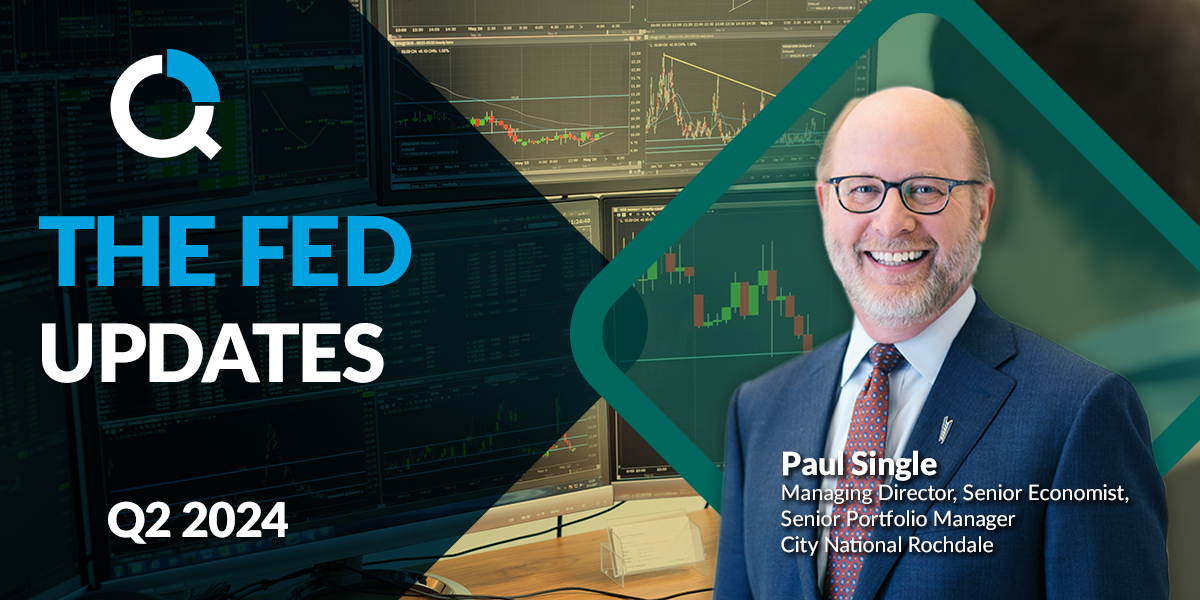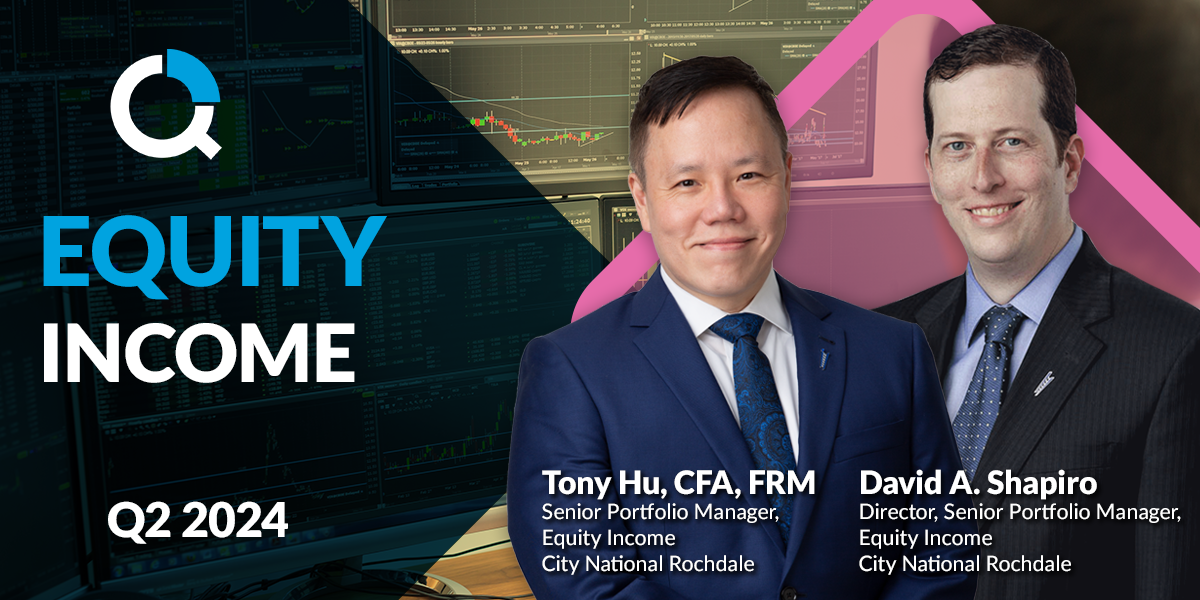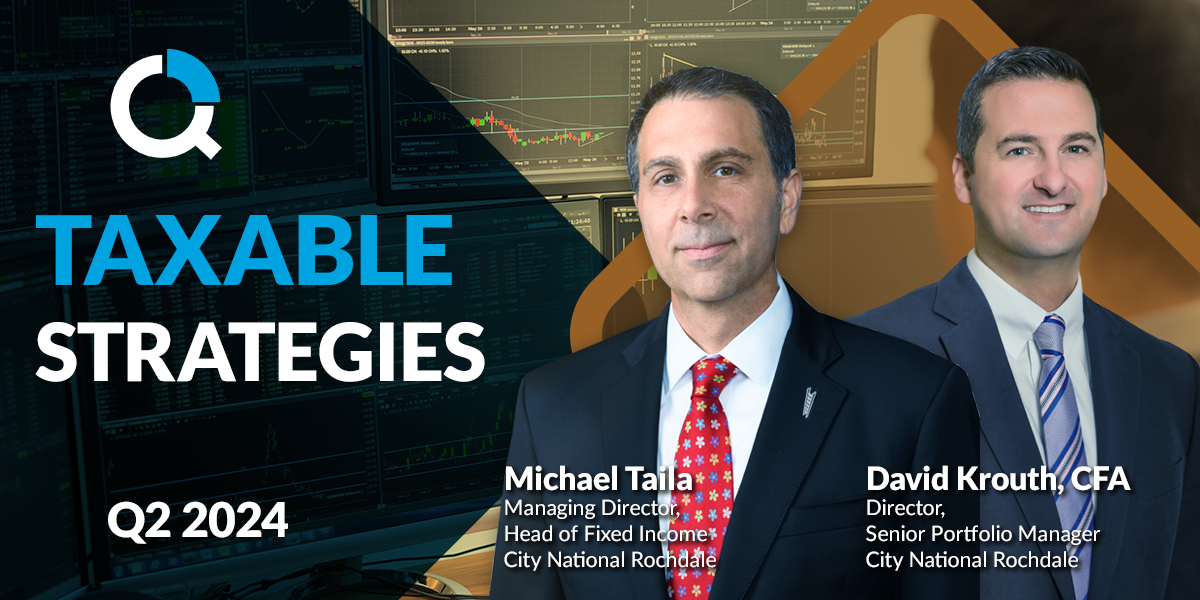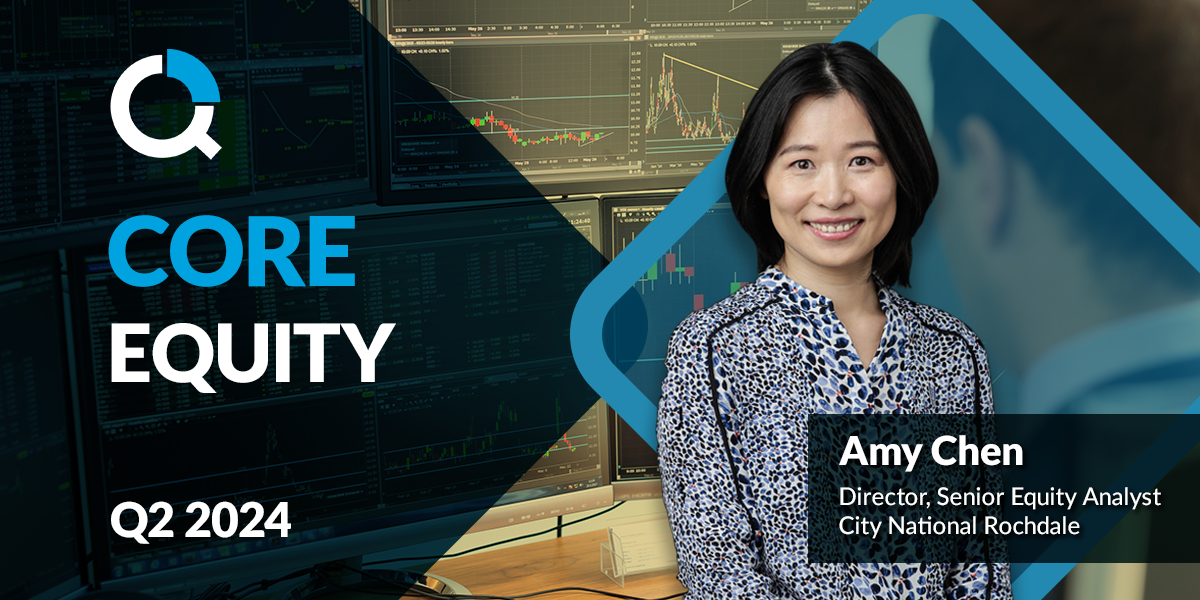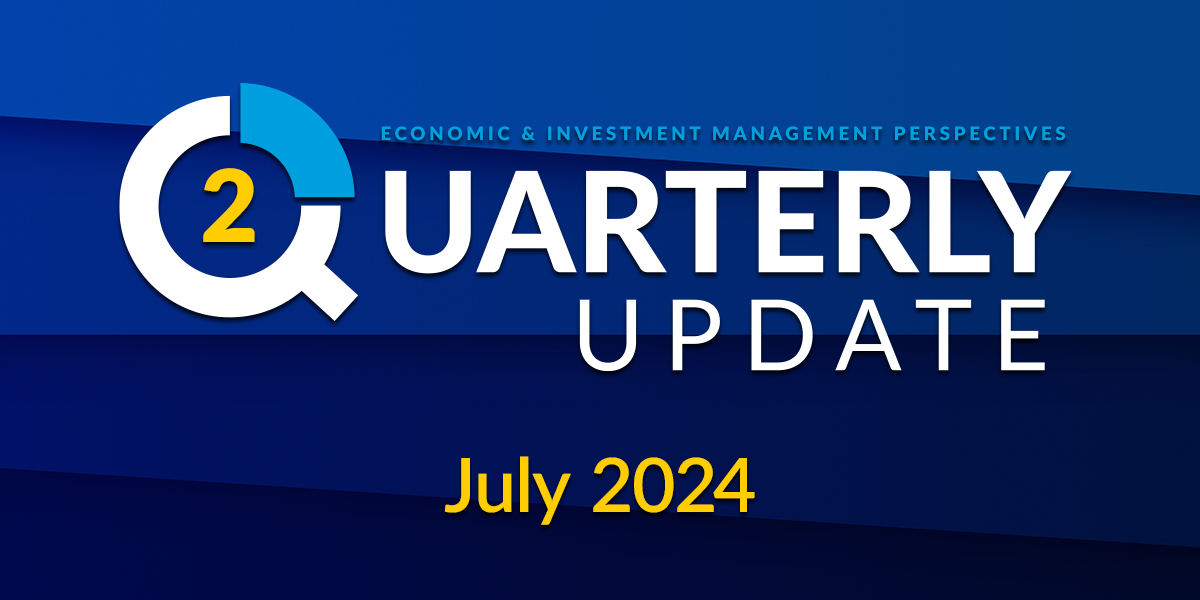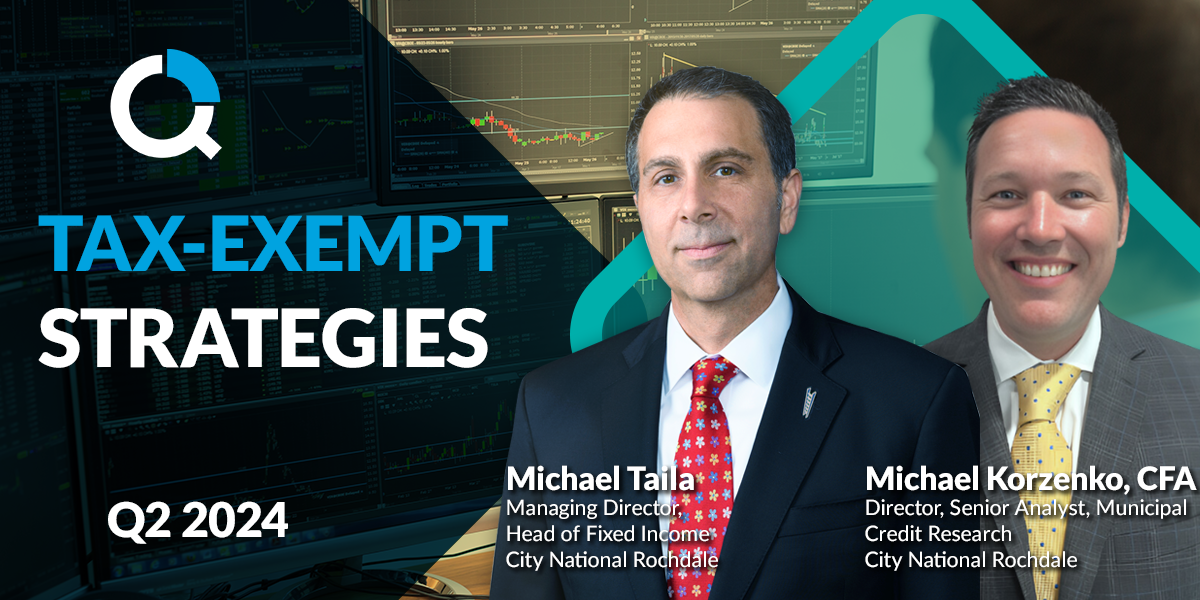
Taxable Strategies: Interest Rates Aren’t Done Moving Higher
Key Points
- The 10-Year U.S. Treasury Yield set a new high of 4.8%.
- Floating rate high yield has benefited from a stronger economy and is out-performing.
- Portfolios should be positioned conservatively in strong companies.
The third quarter was characterized by a resumption in the higher-for-longer trend. The U.S. 10-Year Treasury Note moved higher by 1.05%, ending the quarter at 4.8% and putting last October’s interest rate peak of 4.2% in the rear-view mirror1.
While high starting yields helped offset disruptive price moves, it wasn’t enough to keep returns positive and high-quality bond markets gave back most of the 2023 gains. The Bloomberg U.S. Government/Credit Intermediate Index fell -0.8% over the quarter, pushing YTD returns from as high as 3.5% in early May to just 0.7% by September2. While the bond market is experiencing a surge in interest given the rise in yields, investors should remain cautious on the overall level of rates and the economic factors, such as inflation, tight labor markets and geopolitical events, that continue to put pressure on yields.
Chart 1: HY FV Spread: January 1997 – August 2023
Source: Bloomberg, CNR Research, as of September 30, 2023.
Indexes are unmanaged and do not reflect a deduction for fees or expenses. Investors cannot invest directly in an index.
While interest rates have been volatile, high yield credit markets continued to perform as high starting yields overwhelmed price movement. Over the quarter, spreads, which measure risk levels in credit, ended where they started at 3.9%3 over comparable U.S. Treasuries and the broad market finished up 0.5%4. Performance began to significantly diverge between floating rate securities and fixed rate securities. High Yield Bank Loans rose 3.43% and are now up 10.2% for the full year, 4.3% above U.S. High Yield Corporate Bonds5. Lower than expected default rates and the increased probability of an economic slowdown as opposed to a recession have fueled high yield returns.
Despite the positive performance of higher yielding debt and the attractiveness of yield levels, we believe now is the time to ensure portfolios are invested in stronger credits that generate free cash flow and can cover rising interest rate costs. Our credit models show that high yield markets could move up by 3% or more6 and we expect volatility as we move into 2024.
Chart 2: U.S. High Yield Fixed Rate vs. Floating Rate Markets
Source: Bloomberg, as of September 30, 2023
U.S. High Yield Bonds: Bloomberg: LF98YW Index: The Bloomberg US Corporate High Yield Bond Index measures the USD-denominated, high yield, fixed-rate corporate bond market. Securities are classified as high yield if the middle rating of Moody’s, Fitch and S&P is Ba1/BB+/BB+ or below. Bonds from issuers with an emerging markets country of risk, based on Bloomberg EM country definition, are excluded. “YW” is the ticker to pull the yield-to-worst on the index.
U.S. High Yield Loans: Bloomberg: LF98TRUU Index: The Bloomberg US Corporate High Yield Bond Index measures the USD-denominated, high yield, fixed-rate corporate bond market. Securities are classified as high yield if the middle rating of Moody’s, Fitch and S&P is Ba1/BB+/BB+ or below. Bonds from issuers with an emerging markets country of risk, based on Bloomberg EM country definition, are excluded. This is the total return index level.
1 U.S. 10-Year Treasury, Source: Bloomberg, Ticker: GT10 Govt., Closing Levels
2 Bloomberg Government/Credit Intermediate Index, Source: Bloomberg, Ticker: LF97TRUU
3 Bloomberg High Yield Corporate Bond Index, Source: Bloomberg, Ticker: LF98TRUU
4 Bloomberg High Yield Corporate Bond Spread Index, Source: Bloomberg, Ticker: LF98OAS
5 Leveraged Loans: Morningstar LSTA Leveraged Loan Index, Source: Bloomberg, Ticker: SPBDAL
6 Proprietary Fair Value Spread Model, Source: CNR
Past performance or performance based upon assumptions is no guarantee of future results.
Index performance is provided as a benchmark. It is not illustrative of any particular investment.
Indices are unmanaged, and one cannot invest directly in an index. Index returns do not reflect a deduction for fees or expenses. Indexes are unmanaged and do not reflect a deduction for fees or expenses. Investors cannot invest directly in an index.
Important Information
The views expressed represent the opinions of City National Rochdale, LLC (CNR) which are subject to change and are not intended as a forecast or guarantee of future results. Stated information is provided for informational purposes only, and should not be perceived as personalized investment, financial, legal or tax advice or a recommendation for any security. It is derived from proprietary and non-proprietary sources which have not been independently verified for accuracy or completeness. While CNR believes the information to be accurate and reliable, we do not claim or have responsibility for its completeness, accuracy, or reliability. Statements of future expectations,estimates, projections, and other forward-looking statements are based on available information and management’s view as of the time of these statements. Accordingly, such statements are inherently speculative as they are based on assumptions which may involve known and unknown risks and uncertainties. Actual results, performance or events may differ materially from those expressed or implied in such statements.
All investing is subject to risk, including the possible loss of the money you invest. As with any investment strategy, there is no guarantee that investment objectives will be met, and investors may lose money. Diversification may not protect against market risk or loss. Past performance is no guarantee of future performance.
There are inherent risks with equity investing. These risks include, but are not limited to stock market, manager, or investment style. Stock markets tend to move in cycles, with periods of rising prices and periods of falling prices.
There are inherent risks with fixed income investing. These risks may include interest rate, call, credit, market, inflation, government policy, liquidity, or junkbond. When interest rates rise, bond prices fall.
Bloomberg risk is the weighted average risk of total volatilities for all portfolio holdings. Total Volatility per holding in Bloomberg is ex-ante (predicted) volatility that is based on the Bloomberg factor model.
Index Definitions
S&P 500 Index: The S&P 500 Index, or Standard & Poor’s 500 Index, is a market-capitalization-weighted index of 500 leading publicly traded companies in the US It is not an exact list of the top 500 US companies by market cap because there are other criteria that the index includes.
Bloomberg Barclays US Aggregate Bond Index (LBUSTRUU): The Bloomberg Aggregate Bond Index or “the Agg” is a broad-based fixed-income index used by bond traders and the managers of mutual funds and exchange-traded funds (ETFs) as a benchmark to measure their relative performance.
GT10: US Government Treasury Yield
Bloomberg Municipal Bond Index: The Bloomberg US Municipal Bond Index measures the performance of investment grade, US dollar-denominated, long-term tax-exempt bonds.
Bloomberg Municipal High Yield Bond Index: The Bloomberg Municipal High Yield Bond Index measures the performance of non-investment grade, US dollar-denominated, and non-rated, tax-exempt bonds.
S&P Leveraged Loan Indexes (S&P LL indexes) are capitalization-weighted syndicated loan indexes based upon market weightings, spreads and interest payments. The S&P/LSTA Leveraged Loan 100 Index (LL100) dates back to 2002 and is a daily tradable index for the US market that seeks to mirror the market-weighted performance of the largest institutional leveraged loans, as determined by criteria. Its ticker on Bloomberg is SPBDLLB.
Bloomberg US Corporate Bond Index: The Bloomberg Barclays US Corporate Bond Index measures the investment grade, fixed-rate, taxable corporate bond market. It includes USD-denominated securities publicly issued by US and non-US industrial, utility and financial issuers.
Bloomberg US High Yield Index: The Bloomberg US Corporate High Yield Index measures the performance of non-investment grade, US dollar-denominated, fixed-rate, taxable corporate bonds.
Bloomberg: LF98TRUU Index: The Bloomberg US Corporate High Yield Bond Index measures the USD-denominated, high yield, fixed-rate corporate bond market. Securities are classified as high yield if the middle rating of Moody’s, Fitch and S&P is Ba1/BB+/BB+ or below. Bonds from issuers with an emerging markets country of risk, based on Bloomberg EM country definition, are excluded. This is the total return index level.
Morningstar SPBDLLY Index: Yield to maturity time series of the Morningstar LSTA US Leveraged Loan 100 Index. The Morningstar LSTA US Leveraged Loan Index is a market-value weighted index designed to measure the performance of the US leveraged loan market.
Bloomberg Investment Grade Index: The Bloomberg US Investment Grade Corporate Bond Index measures the performance of investment grade, corporate, fixed-rate bonds with maturities of one year or more.
Bloomberg Municipal Bond Index: measures the performance of investment grade, US dollar denominated, long term tax exempt bonds. Bloomberg US Treasury Index: includes all publicly issued, U.S. Treasury securities that are rated investment grade, and have $250 million or more of outstanding face value.
Investment Grade (IG) Municipal Bond Index: The Bloomberg US Municipal Bond Index measures the performance of investment grade, US dollar-denominated, long-term tax-exempt bonds.
High Yield (HY) Municipal Bond Index: The Bloomberg Municipal High Yield Bond Index measures the performance of non-investment grade, US dollar-denominated, and non-rated, tax-exempt bonds.
Definitions
Yield to Worst (YTW) is the lower of the yield to maturity or the yield to call. It is essentially the lowest potential rate of return for a bond, excluding delinquency or default.
P/E Ratio: The price-to-earnings ratio (P/E ratio) is the ratio for valuing a company that measures its current share price relative to its earnings per share (EPS).
City National Rochdale Proprietary Quality Ranking formula: 40% Dupont Quality (return on equity adjusted by debt levels), 15% Earnings Stability (volatility of earnings), 15% Revenue Stability (volatility of revenue), 15% Cash Earnings Quality (cash flow vs. net income of company) 15% Balance Sheet Quality (fundamental strength of balance sheet).
*Source: City National Rochdale proprietary ranking system utilizing MSCI and FactSet data. **Rank is a percentile ranking approach whereby 100 is the highest possible score and 1 is the lowest. The City National Rochdale Core compares the weighted average holdings of the strategy to the companies in the S&P 500 on a sector basis. As of September 30, 2022. City National Rochdale proprietary ranking system utilizing MSCI and FactSet data.
Non-deposit investment Products are: • not FDIC insured • not Bank guaranteed • may lose value
Stay Informed.
Get our Insights delivered straight to your inbox.
More from the Quarterly Update
Put our insights to work for you.
If you have a client with more than $1 million in investable assets and want to find out about the benefits of our intelligently personalized portfolio management, speak with an investment consultant near you today.
If you’re a high-net-worth client who's interested in adding an experienced investment manager to your financial team, learn more about working with us here.

